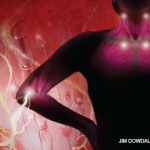

I have come to love Big Data. All it took was a little rubber wristband. Actually, this bangle belongs to my wife. It’s a sleek, powerful device capable of tracking many of her daily activities. Simply connecting it to a smartphone allows her to record her mileage, whether climbing stairs, walking down corridors or trekking through the woods. At night, it analyzes her sleep, using pastel and dark blue shades to highlight the light and deep periods of slumber and a screaming orange to illustrate the times when Linda was just lying awake. The band will chastise her with a hard-to-ignore series of vibrations when she slacks off and compliments her with a thoughtful, data-driven email when she achieves her activity and sleep goals. Although it also tabulates the number of calories Linda purportedly burns throughout the day, I suspect this computation is a guess rather than a realistic estimate. After all, the ability to burn 700 calories while reading a novel sounds far fetched.
A Confluence of Disruptions
Web mobility is a disruptive technology that has profoundly affected our behavior (see Rheuminations, September 2013).1 The first iteration of the World Wide Web was accessed through bulky desktop computers that were connected to the Web via thick cables. The user was kept on a short leash. To a degree, Web 2.0 unchained us. It allowed laptop computers to wirelessly access the Web, but these devices were often too unwieldy to lug everywhere. With Web 3.0, the user was finally unleashed, in part due to the steady downsizing of our mobile devices. Smartphones and tablets weigh just a fraction of most laptops and fit easily into our pockets, purses or satchels.
We truly love our phones and keep them close to our hearts. They have become our lifeline to the world. One recent survey found that 91% of Americans keep their mobile device within reach 24 hours a day.
Coupled to this near limitless mobility are the rapid advancements in cloud computing and data analytics. Big data is the newly coined term used to describe the treasure trove of digital information that we produce and have an increasing ability to store and manipulate. In less than a decade, it has transformed the world of commerce. For example, based on your specific tastes and prior purchases, Amazon and other retailers can target products that you may want to buy, Netflix can offer new movies and shows for you to watch, and Goodreads can recommend novels for you to read.
The development of smartphone apps and global positioning technology has carried data analytics several steps further. For example, it provides the technology behind the workout wristband. It also helps the followers of Yelp find the top-rated pho ga in any neighborhood, anywhere. Retailers can track your movements and analyze your shopping idiosyncrasies as you meander through their stores. Why waste your time just standing in line to buy a cup of coffee? You can browse the Web for airline tickets while waiting for your friendly barista to serve you. However, you may be surprised to learn that your favorite café’s wireless network has captured this bit of information, and somewhere a marketer has filed away your purchase query.
What is so revolutionary about big data is its singular ability to parse information into digestible bits rather than simply collect and store massive piles of material. It’s possible to see the threads that link one set of data points to another. The needles in the haystack can be found. Big data analytics have provided a windfall for business consultants who consider it to be the “next frontier for innovation, competition and productivity.”2
Medical app developers are keenly aware of this reality and are now trying to disrupt the way healthcare is rendered. Similar to car computer systems, mobile-health (m-health) devices are sufficiently sophisticated to be capable of continuously collecting and analyzing large reams of data. Each system can alert their owners to potential trouble spots and, when appropriate, encourage users to modify their behavior or take more urgent action. Although automotive computers have been around for years, the m-health field is in its infancy. More than 43,000 m-health apps currently available in Apple’s iTunes store, with just five of them (two are calorie-counters) accounting for 15% of all downloads. Let’s peruse what’s out there.
The Emperor Is Wearing New Gadgets
Not surprisingly, the cardiovascular system has caught the eye of many developers. This makes sense for several reasons. First, heart disease remains the leading cause of death in most Western societies. Second, the concept of optimizing cardiovascular health is well established in the public mindset. Who doesn’t know their latest cholesterol level? Third, it’s fairly straightforward for engineers to capture the heart’s electrical discharge or the pulsatile wave force of blood coursing through arteries. In fact, there are several new devices that, when connected to a smartphone app, can take your electrocardiogram (ECG) and transmit it to your physician. Similarly, there are gadgets that can record and transmit electroencephalograms and electromyograms to neurologists. In the near future, diagnosing sleep apnea may not require an expensive overnight slumber in a sleep lab. In fact, sleep study apps may become so disruptive to the field of sleep medicine that their costly labs may soon become a medical relic.
Given the explosive prevalence of Type 2 diabetes, glucose monitoring has become another intense area of interest. Continuous glucose monitoring can be achieved using a patch or an implanted sensor that periodically checks the glucose level in a user’s subcutaneous tissues and sends the results wirelessly to their phone.3 In an effort to avoid the often dreaded needlestick, engineers at Google are developing contact lenses containing tiny wireless chips and sensors that would measure and transmit the glucose levels in a diabetic patient’s tears.
For the neurotic parents among us, there’s the burgeoning field of “baby wearables,” or clothing embedded with sensors that can transmit an infant’s vital signs and respirations to data-driven (aka anxious!) parents.
Are there any m-health apps that might be suitable for our rheumatology patients? Given the chronicity of many of the diseases that we treat, there has been a focus on collecting behavioral data that may help us better understand how well or how poorly our patients are functioning on the many days between their office visits. Two types of information are collected. Using a smartphone app, patients regularly enter self-reported data through surveys, such as the health assessment questionnaire (HAQ) or other measures of their functional status. Most importantly, this information is supplemented by the collection of data from their phones’ sensors that can measure mobility (in miles) and social interaction (the daily number of phone calls, text messages). More data points should provide more robust data.
There are now sensors that, when fitted into shoes, continuously analyze a patient’s gait. This technology might be useful in developing more customized rehabilitation programs for patients with osteoarthritis.
One of the great challenges in developing m-health apps for our specialty is the difficulty in pinpointing what needs to be measured. After all, where does the immune system reside? Unlike the cardiovascular system or the brain, the whereabouts of the immune system are not readily known. Continuous, in vivo measurements of cytokines and other potential biomarkers circulating in the bloodstream would not provide us with superior data compared to the current ways of getting results by drawing a blood sample. At the present time, the likelihood of a disruptive technology changing our clinical practice seems slim.
On the other hand, there have been some great advances on the musculoskeletal side of rheumatology. A highly innovative form of wearable technology was recently described in Science.4 An international team led by a group of researchers at the University of Texas in Dallas demonstrated that ordinary fishing line and sewing thread could be cheaply converted to create powerful artificial muscles. Twisting together a bundle of polyethylene fishing lines, whose total diameter was only about 10 times larger than a human hair, produced a coiled polymer muscle that could lift 16 pounds. Operated in parallel, similar to how natural muscles are configured, 100 of these could lift about 1,600 pounds. You wouldn’t want to mess with this patient!
There are now sensors that, when fitted into shoes, continuously analyze a patient’s gait. This technology might be useful in developing more customized rehabilitation programs for patients with osteoarthritis.
The Avatar Doctor
Our fishing line enhanced superhuman sounds like a character straight out of a Robin Cook novel. Robin Cook, MD, an ophthalmologist by training, is best known as a prolific writer of the medical mystery genre. In his latest thriller, Cell, the smartphone is poised to take on a new role in medicine, no longer as a mere medical app but as a fully customizable personal physician capable of diagnosing and treating diseases even better than a human doctor.5 Known as the iDoc, it runs amok under the control of—you guessed it—an evil insurance company. The story’s protagonist, George Wilson, MD, a radiology resident, awakens one morning to find his fiancée dead in bed alongside him, not long after she participated in an iDoc beta test. After undergoing imaging procedures, several of his patients who had been part of the same beta test are found dead.
Despite the grim storyline, Dr. Cook is very upbeat about the future of iDoc devices in caring for patients. Together with medical futurist Eric Topol, MD, director of the Scripps Translational Science Institute in La Jolla, Calif., he co-authored a recent opinion piece in The Wall Street Journal about the coming revolution in digital medicine that blurs the lines between fact and science fiction. As they see it, “a sweeping transformation of medicine has begun that will rival in importance the introduction of anesthesia or the discovery of the germ basis of infectious disease. It will change how patients and physicians interact. It will change medical research and therapy.”6

Further, the authors maintain that the digitalization of medicine will not only personalize healthcare, making it possible to customize therapies based on one’s genome, it will democratize medicine, since patients will own their own data and be able to analyze it instantly by connecting to the Web. Their central premise is that your smartphone, loaded with a heuristic medical algorithm, is poised to become an avatar physician, a not-so-evil iDoc. For example, they predict that by sensing certain genomic signals circulating in your bloodstream, it will be able to warn you in advance about an impending heart attack and send you to the hospital. The iDoc will detect infections and refer you to your local pharmacy for the appropriate antibiotic, which it will prescribe.
Of course, being futurists, Drs. Cook and Topol conclude that all this technology will drive down costs and streamline healthcare. Are they kidding?
Let’s start with their concept of a “heuristic medical algorithm.” Computer-based algorithms may work for diagnosing some conditions that have well-established clinical and laboratory criteria, such as myocardial infarction or hyperthyroidism. As rheumatologists, we regularly witness how inept algorithms and Web searches can be for the diseases that we treat. How might they work for, say, lupus? Who has not met the anxious patient, convinced that they have this disease based on a Google search that suggested this diagnosis? Enter the “data”: a low titer-positive antinuclear antibody test, some self-described hair thinning, occasional mouth sores, fatigue, cool fingertips and a faint rash somewhere. Who needs to see a rheumatologist? Or would the detection of the HLA-B27 antigen by iDoc alert the patient that they are at risk for developing an inflammatory disease, when, in reality, the majority of this gene’s carriers are healthy? Yes, I realize that iDoc would be constantly updated with all the relevant genomic data. But is this data important in clinical practice? Would it matter to you if you knew that your patient with rheumatoid arthritis carried the PTPN-22 allele or the shared haplotype?
Frankly, iDoc is a great literary device—the personification of evil. It kills innocent people and is in cahoots with the wicked insurance companies. Speaking of insurance companies, I wonder if iDoc is smart enough to submit prior authorizations for all those drugs it plans to prescribe? Now that would really impress me.
(Also see Expansion of Mobile Health Apps Makes Physicians’ Job Easier.)
Simon M. Helfgott, MD, is associate professor of medicine in the division of rheumatology, immunology and allergy at Harvard Medical School in Boston.
References
- Helfgott SM. How disruptive technology has transformed the medical school classroom. The Rheumatologist. September 2013;7(9):11–13. http://www.the-rheumatologist.org/details/article/5192871/Rheuminations_How_Disruptive_Technology_Has_Transformed_the_Medical_School_Class.html.
- Freeland C (Reuters). In big data, potential for big division. The New York Times. Jan. 12, 2012. http://www.nytimes.com.
- Health and appiness. The Economist. Feb. 1, 2014. http://www.economist.com/news/business/21595461-those-pouring-money-health-related-mobile-gadgets-and-apps-believe-they-can-work.
- Haines CS, Lima MD, Li N, et al. Artificial muscles from fishing line and sewing thread. Science. 2014;343(6173):868–872.
- Cook R. Cell. Putnam Books, New York, 2014.
- Cook R, Topol E. How digital medicine will soon save your life. The Wall Street Journal. Feb 21, 2014. http://m.us.wsj.com/articles/SB1000142405270230397 3704579351080028045594?mod=WSJ_Opinion_LEADTop&mobile=y.



